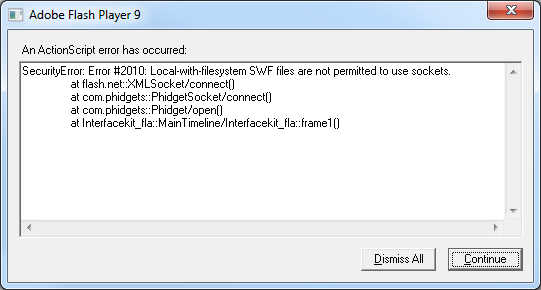|
Notice: This page contains information for the legacy Phidget21 Library. Phidget21 is out of support. Bugfixes may be considered on a case by case basis. Phidget21 does not support VINT Phidgets, or new USB Phidgets released after 2020. We maintain a selection of legacy devices for sale that are supported in Phidget21. We recommend that new projects be developed against the Phidget22 Library.
|
Language - Flash AS3
![]() Flash, developed by Adobe is used to build dynamic multimedia applications to web pages.
Flash, developed by Adobe is used to build dynamic multimedia applications to web pages.
Introduction
If this is your first time working with a Phidget, we suggest starting with the Getting Started page for your specific device. This can be found in the user guide for your device. That page will walk you through installing drivers and libraries for your operating system, and will then bring you back here to use Flash ActionScript specifically.
Flash ActionScript is capable of using Phidgets only over the PhidgetWebService and has support for the complete Phidget API, including events.. We also provide example code in Flash ActionScript for all Phidget devices.
Flash ActionScript can be developed with Windows and Mac OS X.
The library interacts with Phidgets through the use of web sockets.
Only ActionScript 3 is supported.
You can compare Flash ActionScript with our other supported languages.
Quick Downloads
Just need the Flash ActionScript documentation, drivers, libraries, and examples? Here they are:
Documentation
Example Code
Library and Example Code
Libraries and Drivers
- 32-bit Windows Drivers Installer
- 64-bit Windows Drivers Installer
- Windows Driver and Library Files (Zipped)
- OS X Drivers Installer
Getting started with Flash ActionScript
If you are new to writing code for Phidgets, we recommend starting by running, then modifying existing examples. This will allow you to:
- Make sure your libraries are properly linked
- Go from source code to a test application as quickly as possible
- Ensure your Phidget is hooked up properly
Instructions are divided up by operating system. Choose:
- Windows 2000 / XP / Vista / 7
- Mac OS X
- Linux (including PhidgetSBC)
Windows(2000/XP/Vista/7)
Description of Library
Flash ActionScript programs on Windows depend on the following files and folders. The installers in the Quick Downloads section put only the phidget21.dll into your system. You will need to manually put the com folder onto your system.
phidget21.dllcontains the actual Phidget library, which is used at run-time. By default, it is placed inC:\Windows\System32.comfolder is the Phidget ActionScript library. It is to be placed in the same directory as your project root.
If you do not want to use our installer, you can download the phidget21.dll and manually install them where you want; refer to our Manual Installation Instructions.
Flash Professional
Use Our Examples
As the Flash ActionScript library only supports communication with Phidgets through the PhidgetWebService, begin by starting the PhidgetWebService with the default port(5001).
To run the examples, you download the examples and unpack them into a folder. Here, you will find example programs for all devices. If you aren't sure what the software example for your device is called, check the software object listed in the Getting Started Guide for your Device.
After you have found your example, open the .fla file in the Adobe Professional Flash environment. The only thing left to do is to run the examples! Click on Control → Test Movie.
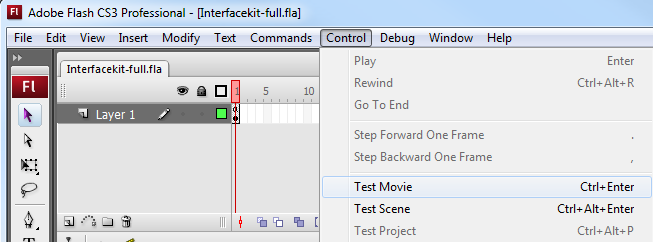
Once you have the Flash ActionScript examples running, we have a teaching section below to help you follow them.
You may also run the examples by navigating to Control → Test Scene. If you are running the examples with Debug → Debug Movie, you will have to change the Flash Global Security Settings in order for the example to run. More information will be provided about the Flash Global Security Settings in the Write Your Own Code section.
Write Your Own Code
When you are building a project from scratch, or adding Phidget function calls to an existing project, you'll need to configure your development environment to properly link the Phidget ActionScript library. To begin:
1. Generate a new ActionScript 3 Flash file.
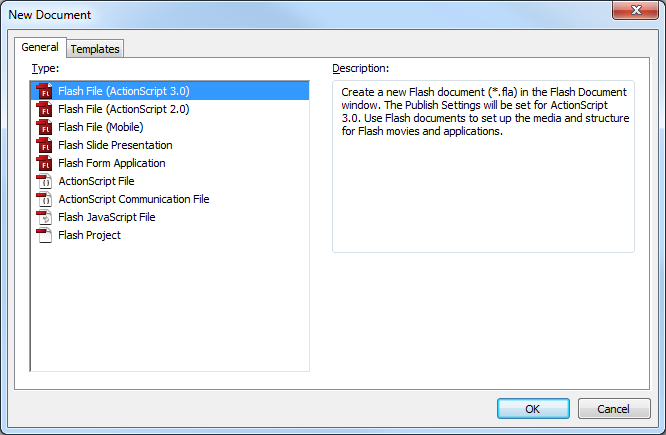
2. Then, in your code, you will need to include the Phidget ActionScript library. Navigate to Window → Actions to bring up the Actions window and enter in the following
import com.phidgets.*;
import com.phidgets.events.*;
The project now has access to the Phidget function calls and you are ready to begin coding.
The same teaching section which describes the examples also has further resources for programming your Phidget.
Running Compiled Code
Running a compiled .swf application will prompt the Flash player to block the application from communicating with the Internet with the following dialog box.
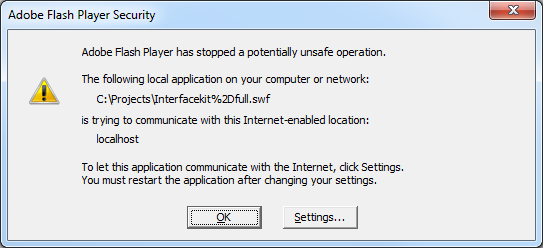
Click on the Settings button to bring up the Flash Global Security Settings Manager in your default web browser. You can also access the manager with the following url: http://www.macromedia.com/support/documentation/en/flashplayer/help/settings_manager04a.html.
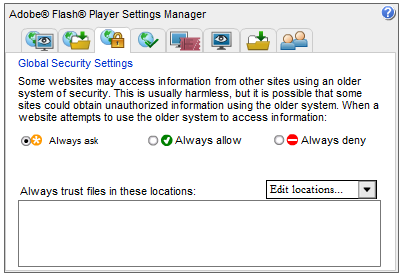
In the Global Security Settings tab, click on Edit locations ... → Add locations
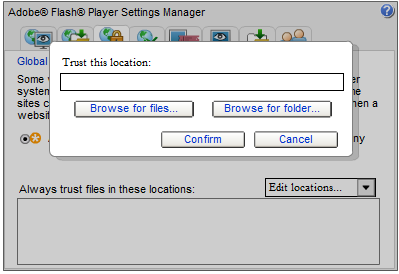
Then, browse and add the application or the folder containing the application.
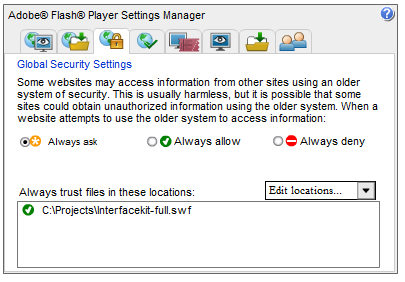
This will allow the Flash Player to accept any Internet communication with the application.
Mac OS X
C/C++ has excellent support on Mac OS X through the gcc compiler.
The first step in using C/C++ on Mac is to install the Phidget C/C++ library. Compile and install them as explained on the getting started guide for your device. Then, the OS - Mac OS X page also describes the different Phidget files, their installed locations, and their roles.
| The information we say that we say on the OS - Mac OS X page (i.e. the different files, locations, and roles) should actually be added there |
Use Our Examples
After installing the Phidget C/C++ library for Mac OS X as above, you're ready to download the examples. Afterwards, unzip the file. To run the example code, you'll need to find the source code for your specific device. Then, compile the code under your platform and run it.
The examples assume that the compiled libraries have been set up properly. To set them up on Mac OS X, follow the Getting Started page for your specific device
To compile, link the Phidget C/c++ library, and build an executable binary on Mac OS X, do (for example, depending on the Headers location):
gcc example.c -o example -framework Phidget21 -I/Library/Frameworks/Phidget21.framework/Headers
After using gcc, you will have an executable named example that you can run.
Write Your Own Code
When writing your code from scratch, you must include a reference to the library header:
#include <phidget21.h>
Then, you would compile your completed C/C++ code the same way as shown in the Use Our Example section above.
To learn how to write your own code for your Phidget, and to learn more about our API, we have a teaching section to help you follow the provided C/C++ examples. Even more help and references are provided from there.
Follow the Examples
By following the instructions for your operating system and compiler above, you probably now have a working example and want to understand it better so you can change it to do what you want. This teaching section has resources for you to learn from the examples and write your own.
Next comes our ActionScript API information, with syntax for all of our functions:
- ActionScript API (This is the complete set of functions you have available for all Phidgets)
- Device Specific APIs - The one for your Phidget can be found in its user guide.
To learn the details behind opening, configuring, using, and closing your Phidget, try the General Phidget Programming page. That page also describes using the Phidget in an event-driven manner and in a traditional manner, both of which are available in C/C++.
Example Flow
The Hello World example has this general structure so you can follow along. We also have an in-depth general introduction to writing Phidget code (like open, read data, etc), as well as the {{{3}}} for specific syntax:
|
// ----- Event and Other Functions ----- Create any Language-Specific Functions (exception handling) Create General Attach, Detach, and Error Handling Functions:
|
In flash ActionScript, you can name these event functions whatever you like. You will then pass them as function pointers to the Phidget library below in the Main Code section. This hooks them into the actual events when they occur. | |
|
// ----- Main Code -----
Close Device Delete Device
|
Creating a Phidget software object in Flash ActionScript is specific to the Phidget. For a Phidget Spatial, for example, this would involve creating a |
Code Snippets
a single Phidget to be opened by multiple applications - something that cannot be done with the regular interface
Common Problems and Solutions/Workarounds
